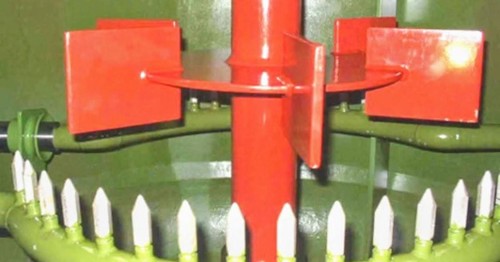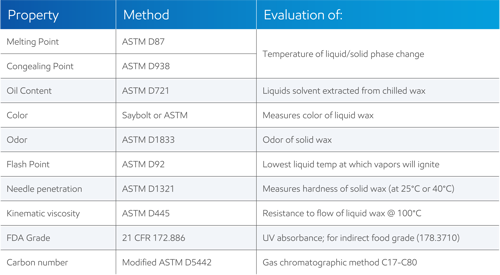Digital Feature: Paraffin wax: A detailed look at its production process
R. BONK, ExxonMobil, Baton Rouge, Louisiana

Paraffin wax is exceptionally versatile: It burns readily, stores heat, repels water, has a variable hardness and is non-toxic. Given these qualities, it is no wonder wax can be found in a wide variety of products that many of us use daily, including candles, cosmetics, tires, hot melt adhesives, PVC piping and paper packaging. But how exactly is paraffin wax made?
The process starts at the crude distillation unit. This unit processes petroleum crude and separates the mixture into different fractions based on their boiling point. The feedstock is heated to high temperatures and undergoes vapor-liquid separations within large distillation towers. By operating under vacuum conditions, fractions that boil at temperatures over 650°F can be separated efficiently at much lower temperatures. This process enables initial control of the final wax’s carbon number and molecular weight distribution so that quality remains consistent every time.
After vacuum distillation, a solvent extraction process removes the polycyclic aromatic molecules, leaving just the oil and wax molecules that are ready for separation. This separation, called dewaxing, is accomplished by crystallizing the wax into a slurry and physically filtering the liquid oil from the solid wax through a cloth. First, solvent is added, and the mixture is chilled to the point where wax has solidified into crystals while the oil remains liquid, creating a slurry.
Wax crystallization: Equipment internals. In traditional dewaxing processes, specialized heat exchangers utilize scraper blades to keep the slurry moving during the chilling process. The author’s company uses a patented dilution-chilling technologya (FIG. 1). This allows for a much more effective crystallization, yielding large wax crystals that can be more easily separated from the oil, resulting in a narrower wax chemical composition.

FIG. 1. The author’s company’s patented dilution-chilling technologya.
Wax filtration: Rotary filter drum in operation. Once the wax has been crystallized, the slurry is sent to a series of rotary filter drums for solid-liquid separation (FIG. 2). The cylindrical drum rotates in a vat of liquid and pulls liquid into the drum via suction. As the drum rotates, solid crystals collect on the cloth, creating a wax cake. Above the liquid surface, the wax cake is washed with additional solvent to reduce the oil content of the wax. At the end of the rotation, wax is removed from the cloth with nitrogen gas into the wax boot, physically separating the solid wax from the liquid lubricant. This process can be repeated with multiple stages of dewaxing to reduce the wax’s oil content to a very low level.

FIG. 2. Rotary drum filter in operation.
The dewaxing process results in a paraffin wax called “slack wax,” which can still contain 5%–30% oil. Slack wax has various applications, including as a water-proofing sealant for wood composites. However, many other applications require a more refined wax with less oil and a higher purity.
For such applications, an additional process called deoiling can be used to further refine wax to achieve low oil content. The deoiling process uses the same technology as dewaxing but operates at a higher temperature. While dewaxing occurs at lower than 15°F, deoiling happens at temperatures greater than 50°F. By heating the slack wax during deoiling, the less crystallizable molecules will melt back into a liquid. When these molecules are filtered from the wax, it results in deoiled wax with lower oil content and increased hardness.
Hydrofinishing: Catalytically removing impurities. Hydrofinishing is a final step that is required to improve wax quality even further (FIG. 3). Hydrofinishing utilizes very high temperatures and pressures to eliminate impurities in the wax, with hydrogen used to catalytically react and remove substances such as sulfur, nitrogen and polar compounds. This process improves color and odor, resulting in an odorless, white paraffin wax product called either semi-refined or fully refined wax, depending on its oil content.

FIG. 3. Hydrofiner unit at ExxonMobil’s Baton Rouge, Louisiana facility.
Testing: Determining the melting point, hardness and safety. Once the paraffin wax is manufactured, quality testing begins. Extensive tests are performed to ensure a safe, reliable and high-performing product, whether it is slack, semi-refined or fully refined wax. Many quality assurance tests are defined by ASTM International, which develops and publishes technical standards for various products, systems, services and materials, including waxes (FIG. 4).
One of the most essential tests determines melting point, the temperature at which wax transitions from a solid to a liquid. There are two methods that are most used. The ASTM D87 method establishes the melting point by identifying when a wax’s temperature plateaus while cooling from a molten state. An alternative method is ASTM D938, which identifies congealing point, or the highest temperature at which a wax solidifies. In this test, a drop of wax is placed on the end of a thermometer and inserted into a heated flask. The flask is rotated continuously until the wax ball stops rolling, signaling its congealing point.

FIG. 4. ASTM International quality assurance tests.
Another test uses ASTM D1321 to determine the hardness of a wax. This technique positions a weighted needle above solid wax and then releases it. The deeper the needle penetrates the wax upon landing, the softer the wax.
When it comes to safety tests, one of the most important uses ASTM D92 to measure a wax’s flash point, or the lowest liquid temperature at which vapor from a wax will ignite a flame. This helps determine the flammability hazard of a wax, which is critical for any application.
Additional quality tests determine a wax’s color, odor and viscosity, among other features. The exact testing requirements are determined by both the type of wax and sales specifications. Once all the requisite testing has been completed, the wax is ready to be shipped to customers.
From refineries to your homes. To maintain product quality and consistency at the highest standards, ExxonMobil’s waxes are developed, manufactured and commercialized in compliance with a corporate Brand and Product Integrity Management System (BPIMS). BPIMS includes and exceeds ISO 9001, the international criteria for a quality management system. By managing all the steps from crude selection to final wax shipment, ExxonMobil has a holistic control of wax composition and quality to provide consistency, reliability and proven product performance.
The fully refined waxes meet applicable U.S. Food and Drug Administration requirements for indirect food contact, meaning they can safely come in contact with food. In addition, every wax shipment is certified to meet company sales specifications.
Demand for waxes is set to grow over the coming years, thus wax production must increase to satisfy demand. The author’s company has expertise in controlling a wax’s molecular composition from crude selection to final product testing. It is supported by technological knowledge and capabilities, which produces the best wax molecules at the end of a complex refining process. Product integrity will always remain the principal focus, and continuous innovation will never come at the expense of performance and safety.
Quality wax is always top of mind—from the beginning of the wax-making process until the moment customers receive their shipment.
NOTE
a ExxonMobil’s DILCHILL™ process






Comments